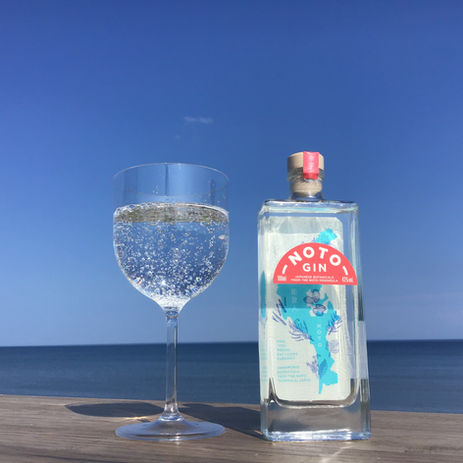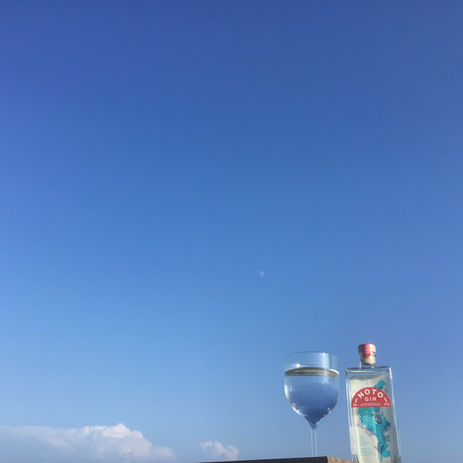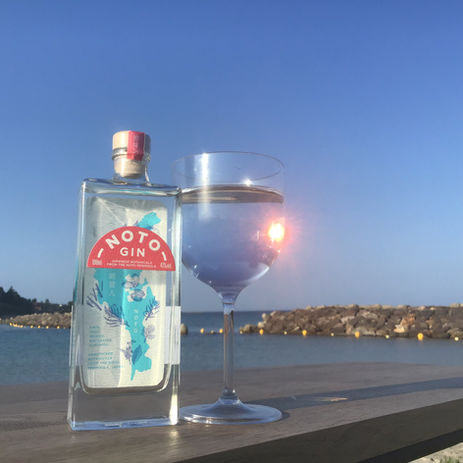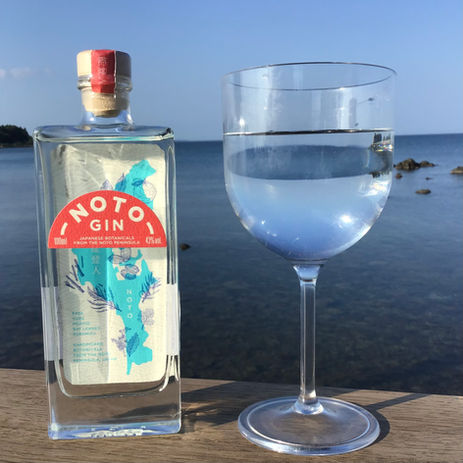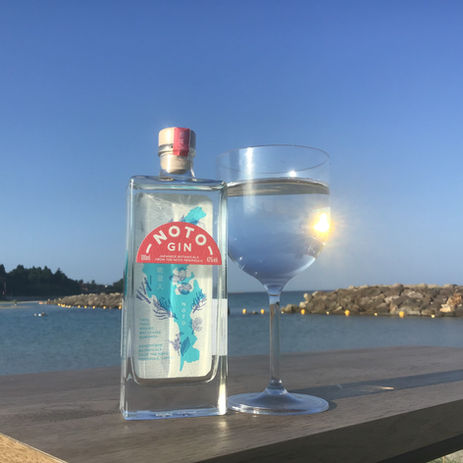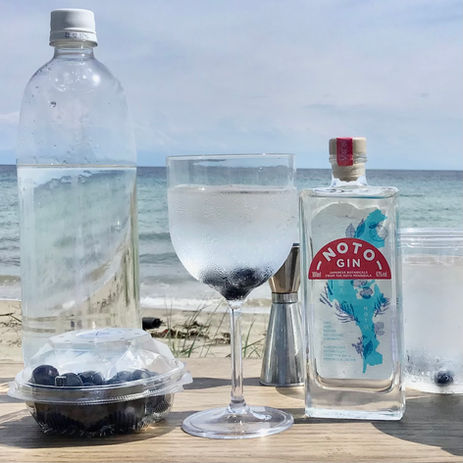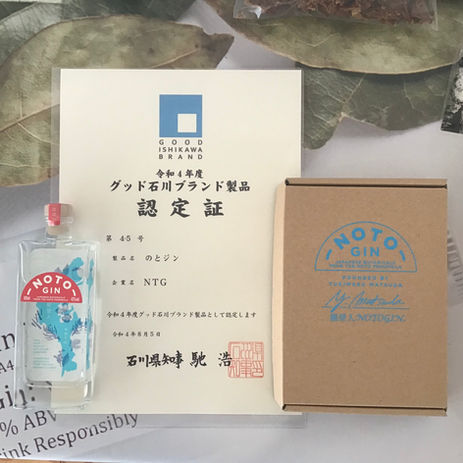SAFETY RESTRICTIONS IN PLACE: Please read our new policies before you visit. More details


NOTO GIN
NOTO
PEOPLE
Where some things are not, but others are.
The stars shining in the sky, the fragrant green satoyama, the blue and rich satoumi, the words exchanged, kind smiles, warm sincerity
A place where things we have forgotten still remain.
That is Noto and Okunoto.
It is because they are so far away that they are difficult to visit.
That's why we want to bring you the freshness of the wind in a bottle.
That is Noto Gin.
Overflowing exhilaration
All I wanted was an overflowing sense of exhilaration.
The fields and mountains where we used to run around,
the sea where we swam until the sun went down.
Rich and forgotten memories in the past.
Recalling what we had forgotten.
The freshness of the breeze,
That's NOTO GIN
Cool, refreshing citrus.

Yuzu

Kaya
Aroma of the windswept forest

Bay leaves

Kuromoji
Spices bringing out the aroma.

Seaweed Salt

Enjoy gin while Contributing to nature conservation
One bottle full of SDG activities in Noto
World Agricultural Heritage and the SDGs
Noto's satoyama and satoumi
Noto's satoyama and satoumi resources, which have been registered as a World Agricultural Heritage site, and the many ways of living in harmony with nature and receiving its bounty, have been handed down to the present day, and a highly sustainable society has been established.
Now, new attempts to achieve the SDGs by 2030 are being made one after another, with the aim of preserving the satoyama and satoumi resources that have been passed down to us forever. We are aiming to preserve the inherited resources of the satoyama and satoumi areas forever.
The tip of the most depopulated peninsula in Japan, It is precisely because we are at the very cutting edge of sustainability that we are taking on this challenge. We are tackling the challenge of sustainability with fun and a smile.
Taking a little bounty from the rich satoyama that stretches across Noto and adding it to a bottle of Noto Gin.

Yuzu
Some people in the Okunoto area grow yuzu at home. They are very familiar to the locals, and the general perception is that yuzu is something we can get. Also, many people grow them but do not harvest them and leave them as they are. Yuzu trees have painful thorns. I were given a small portion of these abundant yuzu trees and only the peels were carefully collected and dried for use. While drying, the fragrance fills the room and you can immerse yourself in a happy feeling.

Bay leaves
Some people plant laurel trees in the Noto area and they also grow wild. It is a relatively common tree in Noto's mountain forests. The laurel tree is so familiar that it is also known as the tree of victory. Because it belongs to the camphoraceae family, it has a rich aromatic composition and a fresh, cool fragrance. In Noto's mountain forests, it is sometimes collected during forest protection thinning operations. Only the leafy parts of the bay tree, collected as thinning timber, are used. Forest protection activities are also utilised in the Noto Gin bottle.

Kaya
Kaya tree produces very fragrant close-margined nuts. Kaya trees grow wild in Noto in the mountains at slightly higher altitudes. Kaya nuts are edible and the pulp has components found in citrus fruits such as limonene and pinene. Locals avoid the plant because of the oiliness of the nuts, which makes them slippery when they fall onto the road. In addition to the Kaya tree, which grows naturally in Noto, we use dried fruit from Kochi Maekawa Seeds, who have been planting trees in Kochi Prefecture for many years.

Kuromoji
The black maple, a member of the camphoraceae family, has attracted attention in recent years as a healing tree. Many grow wild in the forests of Noto. A certain amount of branches and leaves can be collected during thinning operations. Mr. Sano, who produces and sells essential oils from chrysanthemum trees in Yanagida, Noto Town, has provided me with this product. The plant has a cool, soothing and refreshing fragrance and is often used for domestically produced gin.
Extracting the aroma of Noto Gin with a little bounty from the rich satoumi, surrounding Noto.


Seaweed Salt
When we thought about Noto's gin, we wondered if we could make use of its speciality, salt, especially salt from the Agehama method of salt production, which is practised in the Sotoura area from Suzu to Wajima. However, most distillers used the distillation unit made of copper. Salt damages them. Most of the distilleries I consulted said it would be difficult to use salt. However, when I visited In the Welsh Wind distillery in Wales in September 2020, they were very interested in using salt. Their distilling facility actually had experience in producing gin that used salt. As you would expect from a distillery by the sea, they had experience. Indeed, when we asked them about it, we found that the landscape of Wales had many similarities to that of Noto. Shallow sandy beaches, rugged coastlines. It was very easy to find similarities between Noto and Wales, because Wales values its satoyama and satoumi. They also eat a lot of seaweed, which is rare in Europe. The salt we adopted this time was algae salt, which is produced in small quantities on the island of Noto. This was also introduced to us through Ms Fukushima of Notojima Kurashikata Research Institute, who listened to me during the development phase, and it is an algae salt that was produced for a time after the war, but the salt refining had ceased for nearly 50 years and was revived by Mr. Nagasaki, Notojima, some 20 years ago.
This algae salt is produced using wood from thinning in the satoyama as fuel, and is a product of the Satoyama Satoumi conservation activities. In Notojima Shizen no Sato Nagasaki, efforts are being made to improve fallow land, preserve the seaside environment, restore forests and use local resources.
What were you doing before you owned an award-winning gin brand?
I have been working as an employee with several IT companies such as Dell, Amazon, etc. Still I am working with Zendesk continuously.
Why did you want to create a gin brand?
Creating a brand of spirits has been a longtime dream of mine. Especially when I heard my US colleague left the company because he would run a distillery, his career change inspired me. I thought it would be fantastic if I could have a chance to work in a distillery. Whisky has always been attractive to me, however establishing a whisky distillery looked overwhelming to me. Around 2017, I knew that there are many gin distilleries starting up around the world and I thought if it could be a gin distillery, I might have a slight chance to establish. Then my journey started.
What was your inspiration?
The initial inspiration was Noto cider, called Noto Hiba, and I thought Noto botanicals could represent the Noto climate and landscape to attract tourists to visit Noto peninsula.
What is special about the Noto Peninsula?
Noto Peninsula is located where two different ocean tides meet, the warm and cold ones. That makes the climate unique and enriches the variety of botanicals. Noto Peninsula has a low population and the aging population is progressing. There are many botanicals which have no chances to be used in products. As it is an inconvenient area in terms of transportation, there are hidden sceneries that attract us. Especially, some sceneries remind us of the ones in Wales. Noto is surrounded by oceans as Wales is. We have some connections naturally.
Why did you choose the particular botanicals that are used in the gin?
I selected the botanicals which can be reachable and sustainable in production. I wanted to use some fresh and relaxing flavored botanicals which can represent Noto Peninsula.
Why did you choose In the Welsh Wind to develop and distil your gin recipe?
Since the first time I visited the website regarding the own brand service, I wanted to ask my own brand to In the Welsh Wind Distillery. The service attracted me very well.
How easy was the process of working with a distillery to create your gin and your brand?
It was easy with the proper process and experienced navigation by Joe and Ellen. As it was my first attempt, all the processes had to have many questions and it was a time-consuming process to solve the issues. However, Joe and Ellen and all were always helpful and persistent in supporting me to proceed.
What is your favourite way to drink Noto Gin?
As most of the fans do, I like to drink Noto Gin with Soda.
What are your plans for Noto Gin for the future?
I want to sustain this golden recipe of Noto Gin for the future and I want to ensure the production continues. Hopefully once I could reach to establish my own domestic distillery, I would like to succeed the recipe to meet the quality of In The Welsh Wind Distillery.
The packaging is beautiful, well done. Even more beautiful is the gin! It's absolutely delicious, I love the level on the cardamom, it compliments the juniper very well. Super smooth finish, lovely mouthfeel.
New England Distilling, Portland, ME https://newenglanddistilling.com/
We tried it yesterday and we really like it.
Coast Saundersfoot, Saundersfoot, Wales, UK
For your special time
Memories that remain in the back of your mind that are important to you.
Distant memories that you have forgotten in your daily life.
The rich botanical aroma of the Gin and the fragrance of the botanicals
will lead you to the important things you want to retrieve.
Tonic water or soda will enhance the aroma.
I hope you will enjoy the aromatic Noto Gin
in your precious time.







